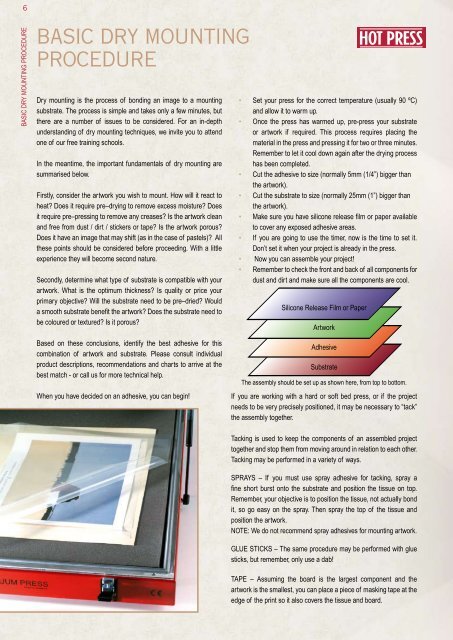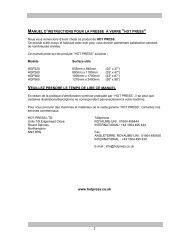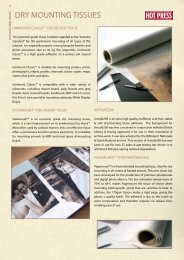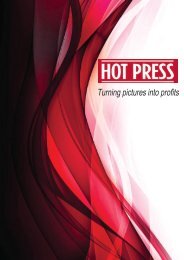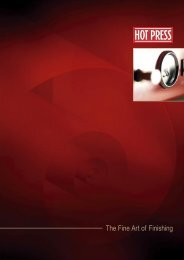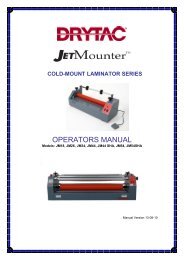The Fine Art of Finishing - Hot Press
The Fine Art of Finishing - Hot Press
The Fine Art of Finishing - Hot Press
- No tags were found...
You also want an ePaper? Increase the reach of your titles
YUMPU automatically turns print PDFs into web optimized ePapers that Google loves.
6<br />
BASIC DRY MOUNTING PROCEDURE<br />
BASIC DRY MOUNTING<br />
PROCEDURE<br />
Dry mounting is the process <strong>of</strong> bonding an image to a mounting<br />
substrate. <strong>The</strong> process is simple and takes only a few minutes, but<br />
there are a number <strong>of</strong> issues to be considered. For an in-depth<br />
understanding <strong>of</strong> dry mounting techniques, we invite you to attend<br />
one <strong>of</strong> our free training schools.<br />
In the meantime, the important fundamentals <strong>of</strong> dry mounting are<br />
summarised below.<br />
Firstly, consider the artwork you wish to mount. How will it react to<br />
heat Does it require pre–drying to remove excess moisture Does<br />
it require pre–pressing to remove any creases Is the artwork clean<br />
and free from dust / dirt / stickers or tape Is the artwork porous<br />
Does it have an image that may shift (as in the case <strong>of</strong> pastels) All<br />
these points should be considered before proceeding. With a little<br />
experience they will become second nature.<br />
Secondly, determine what type <strong>of</strong> substrate is compatible with your<br />
artwork. What is the optimum thickness Is quality or price your<br />
primary objective Will the substrate need to be pre–dried Would<br />
a smooth substrate benefit the artwork Does the substrate need to<br />
be coloured or textured Is it porous<br />
• Set your press for the correct temperature (usually 90 ºC)<br />
and allow it to warm up.<br />
• Once the press has warmed up, pre-press your substrate<br />
or artwork if required. This process requires placing the<br />
material in the press and pressing it for two or three minutes.<br />
Remember to let it cool down again after the drying process<br />
has been completed.<br />
• Cut the adhesive to size (normally 5mm (1/4”) bigger than<br />
the artwork).<br />
• Cut the substrate to size (normally 25mm (1”) bigger than<br />
the artwork).<br />
• Make sure you have silicone release film or paper available<br />
to cover any exposed adhesive areas.<br />
• If you are going to use the timer, now is the time to set it.<br />
Don’t set it when your project is already in the press.<br />
• Now you can assemble your project!<br />
• Remember to check the front and back <strong>of</strong> all components for<br />
dust and dirt and make sure all the components are cool.<br />
Silicone Release Film or Paper<br />
<strong>Art</strong>work<br />
Based on these conclusions, identify the best adhesive for this<br />
combination <strong>of</strong> artwork and substrate. Please consult individual<br />
product descriptions, recommendations and charts to arrive at the<br />
best match - or call us for more technical help.<br />
When you have decided on an adhesive, you can begin!<br />
Adhesive<br />
Substrate<br />
<strong>The</strong> assembly should be set up as shown here, from top to bottom.<br />
If you are working with a hard or s<strong>of</strong>t bed press, or if the project<br />
needs to be very precisely positioned, it may be necessary to “tack”<br />
the assembly together.<br />
Tacking is used to keep the components <strong>of</strong> an assembled project<br />
together and stop them from moving around in relation to each other.<br />
Tacking may be performed in a variety <strong>of</strong> ways.<br />
SPRAYS – If you must use spray adhesive for tacking, spray a<br />
fine short burst onto the substrate and position the tissue on top.<br />
Remember, your objective is to position the tissue, not actually bond<br />
it, so go easy on the spray. <strong>The</strong>n spray the top <strong>of</strong> the tissue and<br />
position the artwork.<br />
NOTE: We do not recommend spray adhesives for mounting artwork.<br />
GLUE STICKS – <strong>The</strong> same procedure may be performed with glue<br />
sticks, but remember, only use a dab!<br />
TAPE – Assuming the board is the largest component and the<br />
artwork is the smallest, you can place a piece <strong>of</strong> masking tape at the<br />
edge <strong>of</strong> the print so it also covers the tissue and board.


